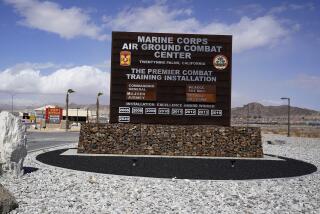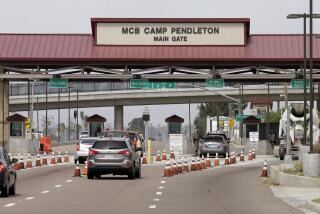4 Marines Die in Helicopter Crash : Desert Accident Involves Craft With History of Problems
- Share via
Four Marines were killed and a fifth injured Friday when a helicopter slammed into the ground during training exercises near Twentynine Palms, the fifth crash in two years of the military’s largest and most powerful helicopter.
The CH53-E Super Stallion helicopter with five Tustin-based Marines on board was on a landing approach, accompanied by two other helicopters, when it crashed shortly after 8 a.m., said Maj. Kerry Gershaneck, spokesman for the Marine Corps Air Ground Combat Center at Twentynine Palms.
“The cause of the accident is under investigation. We don’t know why it crashed. We want to find out quickly,” Gershaneck said.
Identities of the crew, based at the Marine Corps Helicopter Station at Tustin, were being withheld until their relatives are notified.
Friday’s tragedy was the latest in a series of crashes that have earned the Super Stallion the worst safety record of any helicopter flown by the Marines. Fifteen servicemen have been killed and nine others injured in five crashes since June, 1984.
In all, 54 U.S. and South Korean Marines have died since 1981 in the Super Stallion or its predecessor, the smaller, twin-engined CH-53D Sea Stallion. Both are manufactured by Sikorsky Aircraft Co. of Stratford, Conn.
Concern over possible defects in the tail assemblies of the Super Stallion prompted the House Armed Services Committee earlier this year to demand information from the Pentagon on what had been done to fix the problem.
Rep. Robert E. Badham (R-Newport Beach), who made the initial inquiries, said Friday that he had been assured that the tail assemblies had been fixed.
But if Friday’s accident proves to be mechanically related, Badham said, “I will immediately call for a thorough investigation to see if what did happen had any relation whatsoever to any of the previous accidents.”
The Marine Corps has not released the results of investigations of the earlier accidents. Sikorsky has referred all inquires to the military.
“We have confidence in that aircraft, and in its abilities. We have not found any reason to cease operating that helicopter,” said Maj. Anthony Rothfork, a Marine Corps spokesman in Washington. Investigations of previous Super Stallion accidents have revealed “no common threads” that would lead the Marine Corps to believe that the craft experienced any common mechanical problems, Rothfork said in a telephone interview.
He said he was unaware of the tail assembly problems discussed before the Armed Services Committee in March.
More to Read
Sign up for Essential California
The most important California stories and recommendations in your inbox every morning.
You may occasionally receive promotional content from the Los Angeles Times.










